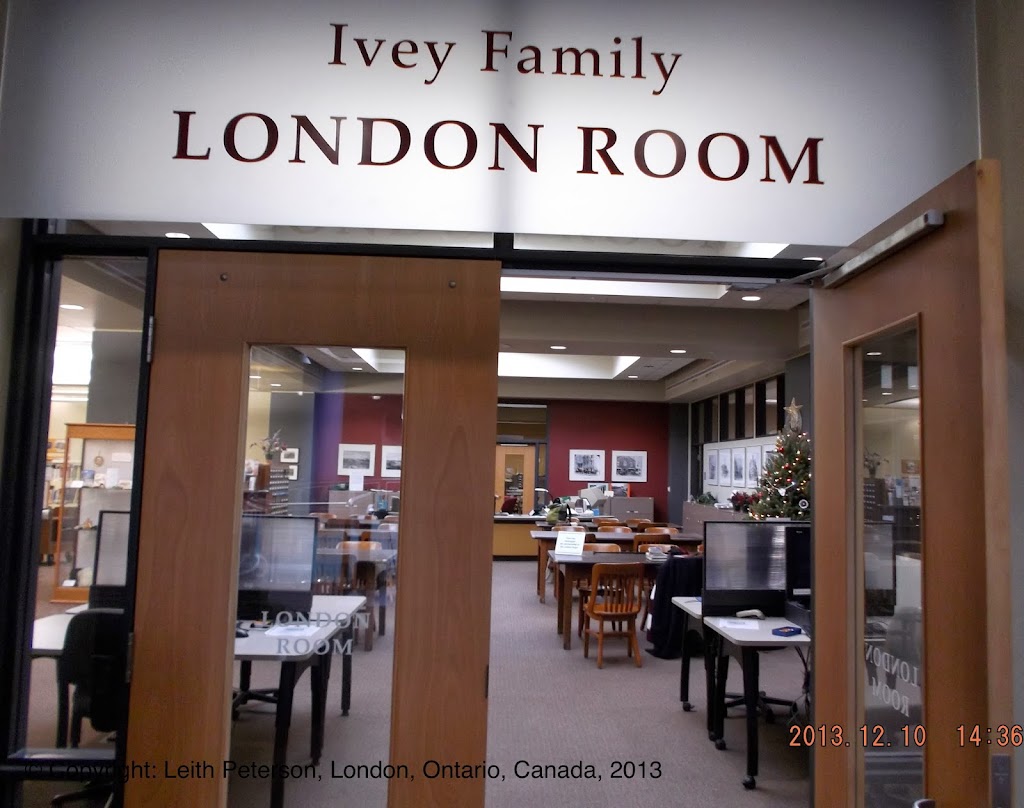For the past four years (2010-2013), I have incorporated my late mother, Jay Peterson’s, Christmas artwork into greeting cards, and have then mailed or hand delivered them before Christmas. I plan to carry on this practice, because I have quite a few more examples of her artwork to choose from. Am grateful to Jessica at Staples Copy and Print who has been able to fit the non-standard images into the templates for the last four years.
I got the original idea for using my mother’s artwork in my cards from family friends James Reaney (1926-2008) and his wife Colleen Thibaudeau Reaney (1925-2012). This dynamic couple included Jamie’s artwork, and either one or the other’s poetry, in their Christmas cards for many years. Other family members also participated in this creative endeavour. Son James Stewart Reaney and his wife Susan Wallace have carried this tradition forward to the next generation.
One of my main motivations for starting this project in the first place was because my four nieces and one nephew were all born after my mother passed away. I hoped my initiative would help them connect with their maternal grandmother. The cards have proven to be very popular, not only with my nieces and nephew, but also with many other family members. In addition, they have been well-received by a lot of friends and associates.
The source of the artwork for my Christmas cards is a binder that my mother assembled, which includes her projects from about 1935 to 1955. As I understand it, she sent material to my late maternal grandparents as she produced it, and they added it to the binder (the scrapbook pages often include date notations). I am very glad my mother’s sister, my Aunt Kay (1922-1997), gave me this binder about 22 years ago.
Ivey Family London Room, London Public Library
One of the recipients of my four cards has been the Ivey Family London Room at the London Public Library, here in London, Ontario, Canada.
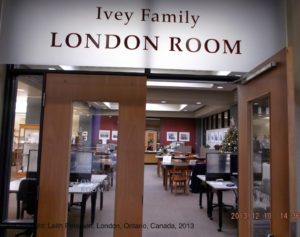 |
| Ivey Family London Room entrance, December 10, 2013 |
The nucleus for what was to become the London Room commenced around 1917, when the London Public Library implemented a local history preservation policy. The concept of a separate room for this material, which was first proposed around 1965, came to fruition in 1967, when the London Room officially opened. This dedicated space has moved a couple of times since then, and is now located on the third floor of the London Public Library Central Branch on Dundas Street.
As explained in a September 2012 brochure, the “London Room is a research facility for genealogy and local history, housing a wealth of original and secondary source materials about the City of London and Middlesex County.” Material in this collection “does not circulate and must be used within the London Room.”
About a year ago, the London Room Librarian, Arthur McClelland, asked me if I could provide additional copies of my cards, so they could be used in Christmas card displays. I was referred to Jill, the Information Services Assistant at the London Room, who looks after these displays.
Jill said it is believed that Elizabeth Spicer, who was the first London Room Librarian, started collecting the Christmas cards around the time the London Room opened in 1967. She said the cards either feature London scenes, or are made by London artists and/or poets. Christmas cards that are sent directly to the London Room are also included.
I provided Jill with two of each of my four cards, so she could show both the front and the back, along with some contextual information about each card, and a printout of a May 4, 2012 post about my mother, entitled “Jay Peterson (1920-1976),” that can be found here.
London Room Display of Jay Peterson Artwork
On December 10, 2013, I went down to the London Room to see the fine tribute that Jill had assembled. Coincidentally, my mother passed away 37 years ago, December 15, 1976.
Here is the sign that can found outside the London Room entrance. There is an identical sign above the display inside the London Room:
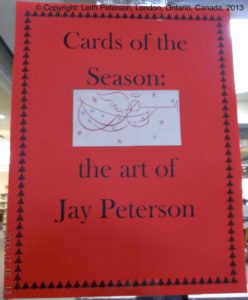 |
| Sign designed by Jill of London Room staff |
Below is a photo of McClelland and I standing on each side of the display:
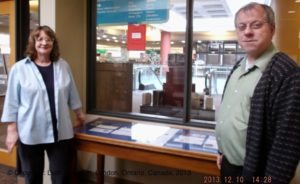 |
| Leith Peterson, left, and Arthur McClelland |
The photo below is of the left side of the display case:
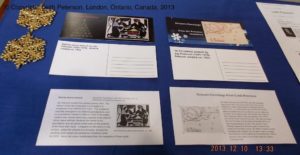 |
| Left side of London Room display case |
The image and explanation for the nativity scene artwork in the first column can be found in the previously mentioned May 4, 2012 post, located here.
The trumpeting angel artwork is featured in the second column. It is the same image used in the display sign. This angel is part of a Christmas card my mother presumably did for my maternal grandparents around 1955. “Mr. and Mrs. Stuart Fleming” appeared at the bottom right (I removed their names from the image I used). My mother’s original creation included another graphic and was quite complex, but I will leave you in suspense about the particulars. This is because I may want to use the other image for a future Christmas card.
The middle section of the display case features the printout of my previously mentioned May 4, 2012 post:
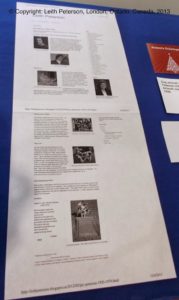 |
| Middle section of display case |
The first column on the right side of the display case:
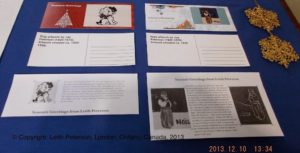 |
| Right side of display case |
includes a puppy my mother drew, ca. 1935-1936:
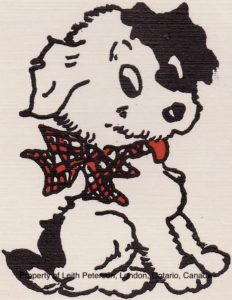 |
| Jay Peterson puppy artwork, ca. 1935-1936 |
The original version of this puppy artwork had the words “Merry Christmas and a Happy New Year – Jessie Fleming.” (Fleming was my mother’s maiden name.)
The artwork in the second column is of a pensive-looking fellow:
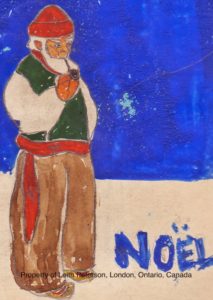 |
| Jay Peterson Noel artwork draft, ca. 1939 |
It appears to be the draft for the relief print (linocut?) that is pictured below:
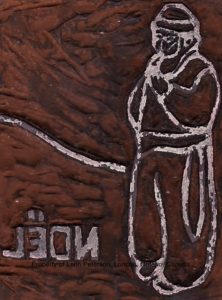 |
| Jay Peterson Noel linocut, ca. 1939 |
At the bottom of the page where the Noel drawing appears in the binder, “Xmas 1939 Jay” is pencilled in, so presumably the relief print was used to make Christmas cards for that year. I scanned the drawing and then duplicated it so I could retouch it, but decided in the end to leave it in its authentic state. For some reason, I think my mother would prefer it this way.
I am pleased that the London Room is featuring these four cards, and hope the display is of interest to the people who view it.
